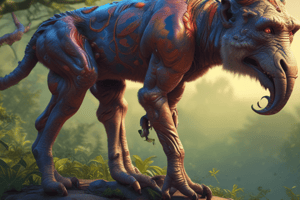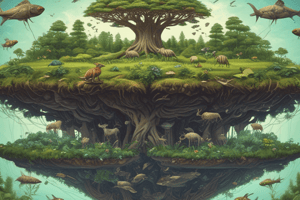Podcast
Questions and Answers
What is a selecting agent?
What is a selecting agent?
- A nonliving factor affecting organisms
- A type of environmental factor that creates a selection pressure (correct)
- An individual that has a selective advantage
- An adaptation that improves survival
Biotic factors are nonliving factors that affect organisms.
Biotic factors are nonliving factors that affect organisms.
False (B)
Define 'selection pressure' in your own words.
Define 'selection pressure' in your own words.
Selection pressure refers to factors that impact an organism's ability to survive and reproduce in a specific environment.
The introduction of cane toads in Australia was intended to control __________.
The introduction of cane toads in Australia was intended to control __________.
Match the following examples with their corresponding types of factors:
Match the following examples with their corresponding types of factors:
Which of the following is a consequence of the high reproductive rate of cane toads?
Which of the following is a consequence of the high reproductive rate of cane toads?
Cane toads are considered a successful biological control method for pest beetles in Australia.
Cane toads are considered a successful biological control method for pest beetles in Australia.
What selective advantage have cane toads gained in new areas?
What selective advantage have cane toads gained in new areas?
What is natural selection primarily known as?
What is natural selection primarily known as?
Microevolution refers to large-scale changes within a species over long periods of time.
Microevolution refers to large-scale changes within a species over long periods of time.
What are the five points of natural selection?
What are the five points of natural selection?
The theory that suggests evolution occurs in short bursts followed by long periods of stability is called __________.
The theory that suggests evolution occurs in short bursts followed by long periods of stability is called __________.
Match the types of evolution with their descriptions:
Match the types of evolution with their descriptions:
Which of the following is NOT a mechanism that drives evolutionary change?
Which of the following is NOT a mechanism that drives evolutionary change?
Darwin and Wallace's theory of evolution explains that species can evolve under identical environmental pressures.
Darwin and Wallace's theory of evolution explains that species can evolve under identical environmental pressures.
What is the main outcome when advantageous traits are passed on to the next generation?
What is the main outcome when advantageous traits are passed on to the next generation?
In macroevolution, focus is on evolutionary changes at the __________ level.
In macroevolution, focus is on evolutionary changes at the __________ level.
Which of the following is an example of adaptation?
Which of the following is an example of adaptation?
Genetic drift is a mechanism that can change trait frequencies due to chance events.
Genetic drift is a mechanism that can change trait frequencies due to chance events.
Give an example of directional selection.
Give an example of directional selection.
In natural selection, an organism's ability to survive and reproduce depends on its __________ to the environment.
In natural selection, an organism's ability to survive and reproduce depends on its __________ to the environment.
What does the term 'overproduction' in natural selection refer to?
What does the term 'overproduction' in natural selection refer to?
Which method measures the degree of similarity between DNA from two species using UV light?
Which method measures the degree of similarity between DNA from two species using UV light?
Homologous structures are those that evolved independently to perform the same function.
Homologous structures are those that evolved independently to perform the same function.
What is comparative anatomy the study of?
What is comparative anatomy the study of?
The inner ear bones of mammals are homologous to the ______ bones of reptiles.
The inner ear bones of mammals are homologous to the ______ bones of reptiles.
Match the following fossil types with their descriptions:
Match the following fossil types with their descriptions:
What temperature must DNA be heated to in order to separate its strands?
What temperature must DNA be heated to in order to separate its strands?
Vestigial structures are features that currently serve a significant function for the species.
Vestigial structures are features that currently serve a significant function for the species.
What phenomenon demonstrates modern-day evolutionary change in bacteria?
What phenomenon demonstrates modern-day evolutionary change in bacteria?
The ______ arches in mammal embryos are considered homologous to the gill slits of fish.
The ______ arches in mammal embryos are considered homologous to the gill slits of fish.
Match the following dating techniques to their descriptions:
Match the following dating techniques to their descriptions:
Which of the following is an example of an analogous structure?
Which of the following is an example of an analogous structure?
Cane toads have evolved to travel slower since their introduction to Australia.
Cane toads have evolved to travel slower since their introduction to Australia.
How does the presence of vestigial structures support the theory of evolution?
How does the presence of vestigial structures support the theory of evolution?
What can cane toads affect when predators consume them?
What can cane toads affect when predators consume them?
Declines in native species such as large goannas and northern quolls are attributed to habitat loss due to cane toads.
Declines in native species such as large goannas and northern quolls are attributed to habitat loss due to cane toads.
What adaptation allows koalas to survive on gum leaves despite their low nutritional value?
What adaptation allows koalas to survive on gum leaves despite their low nutritional value?
Cactoblastis Cactorum was introduced to control the population of __________ in Australia.
Cactoblastis Cactorum was introduced to control the population of __________ in Australia.
Match the following types of adaptations with their definitions:
Match the following types of adaptations with their definitions:
Which of the following is an example of a structural adaptation?
Which of the following is an example of a structural adaptation?
Charles Darwin's theory of evolution emphasizes that all individuals in a species are genetically identical.
Charles Darwin's theory of evolution emphasizes that all individuals in a species are genetically identical.
What process did Charles Darwin associate with the survival of species over generations?
What process did Charles Darwin associate with the survival of species over generations?
The beak shape of finches in the Galapagos Islands serves as an example of an __________ that contributes to their survival.
The beak shape of finches in the Galapagos Islands serves as an example of an __________ that contributes to their survival.
Match each animal with its adaptation:
Match each animal with its adaptation:
What was one of the ecological effects of the introduction of prickly pear in Australia?
What was one of the ecological effects of the introduction of prickly pear in Australia?
Invasive species like cane toads compete with native animals for resources.
Invasive species like cane toads compete with native animals for resources.
What coupled relationship did Darwin observe between finches and their food sources?
What coupled relationship did Darwin observe between finches and their food sources?
The __________ introduced in the 1920s helped to control the prickly pear population in Australia.
The __________ introduced in the 1920s helped to control the prickly pear population in Australia.
Which of the following is not a type of adaptation?
Which of the following is not a type of adaptation?
Study Notes
Selection Pressure
- Selection pressures influence an organism's survival in an environment and can be biotic (living factors) or abiotic (nonliving factors).
- Examples include predation pressure, which can lead to adaptations such as speed in prey animals and camouflage in predators.
- A selecting agent is a specific factor prompting selective pressure, such as cheetahs pressuring wildebeest to be faster.
Biotic and Abiotic Factors
- Biotic factors include predation, food availability, competition, and disease.
- Abiotic factors encompass temperature, light intensity, water availability, soil pH, mineral content, and atmospheric gases.
Cane Toads in Australia
- Introduced in 1935 for pest control, cane toads have become invasive, spreading significantly and evolving over 50 generations.
- Long-legged, fast-moving toads at invasion fronts have a selective advantage, facing less competition for resources.
- Cane toads lay 30,000 eggs at a time and possess poison glands that threaten native predators, leading to species decline (e.g., goannas, northern quolls).
Prickly Pear Distribution in Australia
- Introduced from South America, prickly pear became invasive, rendering 40,000 km of farmland unproductive.
- The introduction of the Cactoblastis moth larvae effectively reduced prickly pear populations, showing biotic selection pressure in action.
Adaptations
- An adaptation is a modification that improves survival in specific environments.
- Structural adaptations involve physical changes, such as blubber in whales for insulation or long fingers in fruit bats for wing support.
- Physiological adaptations include internal changes, such as koalas' low metabolic rates for digesting low-nutrition gum leaves and rattlesnakes producing venom.
- Behavioral adaptations are voluntary actions, like bats huddling for warmth or possums being nocturnal to avoid heat.
Charles Darwin and Evolution
- Darwin's theory of evolution describes how traits favoring survival become more common over generations ("survival of the fittest").
- Natural selection is driven by variations in species, leading to increased survival and reproduction of individuals suited to their environments.
- Finch populations in the Galapagos showcased adaptation through varying beak shapes suited for local resources.
Theory of Evolution by Natural Selection
- Variation, overproduction, competition, adaptation, and speciation are key elements in natural selection.
- Microevolution involves small changes in gene frequencies, while macroevolution encompasses larger evolutionary group changes, often traced through fossils.
Divergent and Convergent Evolution
- Divergent evolution occurs when species share a common ancestor but develop different traits due to varying environmental pressures, exemplified by Galapagos finches.
- Convergent evolution arises when unrelated species evolve similar traits due to similar environmental challenges, as seen in sharks and dolphins.
Punctuated Equilibrium vs. Gradualism
- Gradualism proposes a slow, continuous evolution over time with small changes, while punctuated equilibrium suggests rapid changes followed by stability.
- The fossil record supports both theories, showcasing transitional forms and sudden new species appearances.
Evidence for Evolution
- Biochemical, anatomical, embryological, and biogeographic evidence demonstrates evolution.
- Homologous structures indicate common ancestry through evolutionary modifications (e.g., forelimbs of mammals).
- Vestigial structures are remnants of ancestral features that are reduced and no longer serve their original function.
Fossil Dating Techniques
- Fossils are formed through rapid burial to prevent decomposition and can be classified as impressions, preserved remains, or traces.
- Relative dating orders fossils chronologically, while absolute dating estimates their actual ages using radioactivity.
Modern-Day Examples of Evolution
- Cane toad populations exemplify rapid evolution and adaptation post-introduction.
- Antibiotic-resistant bacteria demonstrate modern evolutionary change, with resistant strains surviving treatment and proliferating in populations.### Antibiotic Resistance
- Bacteria can evolve quickly, leading to populations resistant to common antibiotics.
- The rise of antibiotic-resistant bacteria poses a significant challenge in medical treatment.
Cane Toad Introduction to Australia
- Cane toads were introduced to Australia in 1935 and have since proliferated extensively in northeastern Queensland.
- Their spread is facilitated by several adaptive traits and environmental factors.
Traits of Invasive Cane Toads
- Toads at the invasion front typically exhibit straight-line travel and possess longer legs compared to those in established populations.
- Longer legs contribute to greater endurance and enable faster movement to new areas.
Factors Supporting Cane Toad Population Growth
- A lack of natural predators in Australia has contributed to their successful establishment.
- Availability of abundant food resources enhances their breeding success.
- Favourable environmental conditions facilitate their survival and reproduction.
Reproductive Success and Genetic Adaptation
- Cane toads can lay up to 30,000 eggs at a time, significantly increasing population size.
- Genetic changes favor individuals that arrive first to new locations, enhancing their competitive advantage over later arrivals.
- Those who arrive early tend to have access to more resources, leading to higher breeding success due to reduced competition.
Studying That Suits You
Use AI to generate personalized quizzes and flashcards to suit your learning preferences.
Description
Explore the concepts of selection pressure, including biotic and abiotic factors that affect an organism's survival. Understand the role of invasive species like cane toads in Australia and how they adapt to their environments. This quiz will test your knowledge of ecological principles and adaptations.




